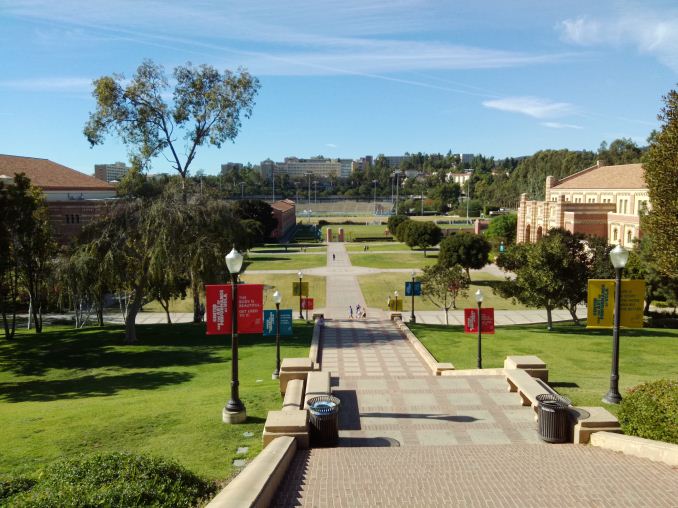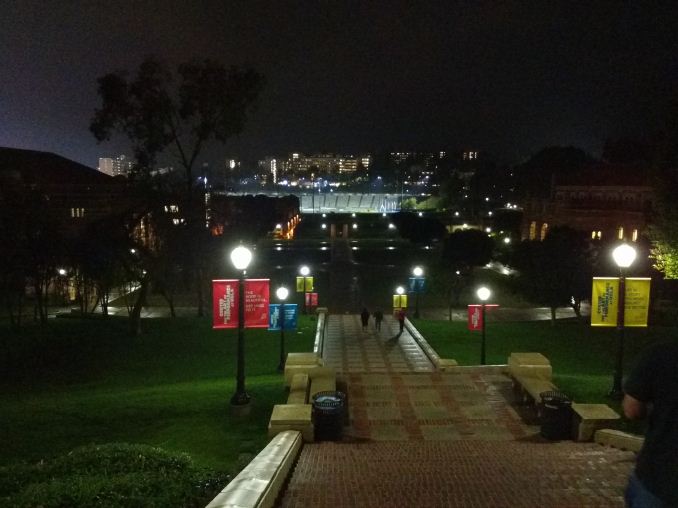The Google Nexus 9 Review
by Joshua Ho & Ryan Smith on February 4, 2015 8:00 AM EST- Posted in
- Tablets
- HTC
- Project Denver
- Android
- Mobile
- NVIDIA
- Nexus 9
- Lollipop
- Android 5.0
Camera
In the case of tablets, cameras have become increasingly important. While it’s still a bit awkware to take photos and video with a tablet, there is still value to having decent cameras on a tablet. For the front-facing camera, it’s pretty clear that there is a lot of value to be had here as the tablet can be a good tool for video conferencing in lieu of a bulky laptop. The rear camera can also have value, but mostly for taking a photo of a whiteboard or simply when opportunity dictates. To fulfill these duties, the Nexus 9 has been outfitted with a rather standard set of cameras. On the rear, we see an 8MP, 1/4 inch format sensor while the front-facing camera has a 1.6MP, 1/5 inch sensor. I’ve included a table of the full camera specs below in the interest of readability.
| Camera Specifications | |||
| Google Nexus 9 | |||
| Front Camera | 1.6MP | ||
| Front Camera - Sensor | OV9760 (1.75µm, 1/5") |
||
| Front Camera - Focal Length | 2.18mm | ||
| Front Camera - Max Aperture | F/2.18 | ||
| Rear Camera - Sensor | IMX219 (1.12 µm, 1/4") |
||
| Rear Camera - Focal Length | 3.097mm (33mm eff) | ||
| Rear Camera - Max Aperture | F/2.4 | ||
This is pretty much par for the course when it comes to tablets. The optics aren’t particularly remarkable in one way or another, as I haven’t noticed any obvious design issues in any of my test photos, and the focal length isn’t excessively long or short. The UI that comes with Google Camera in general is unremarkable as well. This isn’t a slight against it, but the fact that I don’t have anything significant to complain about is a good step forward from the past when the design of the camera UI was a significant friction point in the user experience.
The one issue that I’ve noticed is that the camera’s auto focus and capture speed are significantly worse than what I saw on the iPad Air 2. Unfortunately, it isn’t really possible to have standardized testing here as a tablet can’t be mounted to a tripod for testing. As there isn’t a custom ISP in the Nexus 9, it’s likely that the Tegra ISP isn’t up to scratch here as I noticed that AF speed is similar to what I saw on the SHIELD Tablet despite differing camera modules.
For the most part, there’s not much else to be said about the camera systems on the Nexus 9 as they aren’t quite as heavily focused as one would see in the smartphone space. All that’s left to do is test the cameras themselves.
In this basic test of daytime photo quality, we can see that HTC has done a reasonably good job of processing the image as noise is generally suppressed without an enormous loss of detail. However, there really isn't a lot of detail to speak of in this sensor. There's also a decent amount of dynamic range as there's detail in the shadows but there's no HDR mode to compensate in cases where there is insufficient dynamic range. HTC continues to cap the base ISO to 100, which seems to be a strange move in this situation as the shutter speed is more than high enough to drive the sensor gain even lower.
In this low light scenario, the Nexus 9 effectively falls flat on its face. With an ISO of 3200 and a shutter speed of 1/12s, there's effectively no detail past the first set of steps. Luminance noise is strong and present throughout the image, and color noise also has a tendency to creep in as well. Given the sheer size of the tablet, it's also hard to stably hold the tablet to take a photo despite the relatively fast 1/12s shutter speed. One should really avoid using this to take photos in low light unless there's no other choice.
In video, detail generally tends to be about the same as what one can find in photos, which means that daytime footage should have decent quality but low light rapidly reduces the quality as the sensor gain must increase. In the case of the Nexus 9, we see that video tops out at 1080p30 maximum with no slow motion available, and that the file is in a .3gp format instead of a standard mp4 that most are familiar with. The video itself is encoded with H.264 baseline at 14 Mbps, which is likely to be below the maximum that the encoder can support. There doesn't appear to be any significant level of stabilization in this case, which is a bit disappointing although not entirely surprising. There is also a lot of focus hunting throughout the video, which is quite distracting.
Overall, it seems that the camera on the Nexus 9 is an acceptable one for a tablet, although this would effectively be unacceptable on a high-end smartphone. The camera itself produces decent output in daytime but really suffers in low light due to the small pixel size, relatively narrow aperture, and small sensor. There are also a lot of issues with consistent and reliable auto focus, as it often takes multiple focus runs to get the camera to focus properly on even high contrast objects. Each focus run takes a significant amount of time as well, which hurts the shooting experience when combined with the somewhat long capture latency. I would avoid using this camera unless it is strictly necessary, although it isn't terrible as a camera for cases such as document scanning.
























169 Comments
View All Comments
rpmrush - Wednesday, February 4, 2015 - link
I find the 4:3 aspect ratio a turn off. Why change now. There are zero apps natively designed for this in the Android ecosystem. Why would a developer make a change for one device? It just seems like more fragmentation for no reason. I'm picking up a Shield Tab soon.kenansadhu - Wednesday, February 4, 2015 - link
One example to drive my point: I bought kingdom rush and found out that on my widescreen tablet, the game won't fit the screen properly. If any, this will fit apps previously designed for ipads well. Hate to admit it, but apple has such a huge lead in the tablet market it's just reasonable for developers to focus on them first.melgross - Wednesday, February 4, 2015 - link
Well, there are almost no tablet apps at all for Android. One reason is because of the aspect ratio being the same for phones and tablets. Why bother writing g a tablet app when the phone app can stretch to fit the screen exactly? Yes, they're a waste of time, but hey, it doesn't cost developers anything either.Maybe goi g to the much more useful 4:3 ratio for tablets will force new, real tablet apps.
It's one reason why there are so many real iPad apps out there.
retrospooty - Wednesday, February 4, 2015 - link
You sound like you are stuck in 2012. Update your arguments ...UtilityMax - Sunday, February 8, 2015 - link
There will be more tablets coming with 4:3 screen. Samsung's next flagship tablet will be 4:3. As much as I like watching movies on a wide screen, I think it's not the killer tablet application for most users, and most people will benefit from having a more balanced 4:3 screen. It works better for web browsing, ebooks, and productivity apps.Impulses - Wednesday, February 4, 2015 - link
Most simpler apps just scale fine one way or the other... I think 4:3 makes a ton of sense for larger tablets, it remains almost exactly as tall in landscape mode (which a lot of people seem to favor, and I find bizarre) and more manageable in portrait since it's shorter.7-8" & 16:9 is still my personal preference, since I mostly use it for reading in portrait. Try to think outside of your personal bubble tho... I bought the Nexus 9 for my mother who prefers a larger tablet, never watches movies on it, yet almost always uses it in landscape.
It'll be perfect for her, shoot, it even matches the aspect ratio of her mirrorless camera so photos can be viewed full screen, bonus.
UtilityMax - Sunday, February 8, 2015 - link
I personally think about the reverse. Big tablets with 9-11 screens are often bought for media consumption. Because of that, it makes sense for them to come with a wide screen. For me, having wide screen for watching movies on the flights and in the gym was one of the prime reasons to buy a Samsung Galaxy Tab S 10.5, even though its benchmarks look only so so.However, a 9 to 11 inch tablet is too bulky to hold in one hand and type with another. It almost begs for a stand. So for casual use, like casual web browsing or ebook reading, a smaller tablet with a 4:3 screen works better. And so I went ahead and got a tablet with 4:3 screen for that purpose.
Impulses - Monday, February 9, 2015 - link
Valid points, obviously usage cases can differ a lot, that's the nice thing about Android tho... It doesn't have to conform to any one aspect ratio that won't fit everyone's taste.LordConrad - Wednesday, February 4, 2015 - link
I love the 4:3 aspect ratio. I primarily use tablets in Portrait Mode, and have always disliked the "tall and thin" Portrait Mode of traditional android tablets. This is the main area where Google has always fallen behind Apple, IMHO. This is the main reason I gave my Nexus 7 (2013) to my nephew and bought a Nexus 9, and I have no regrets.R. Hunt - Thursday, February 5, 2015 - link
Agreed. I understand that YMMV and all that, but to me, large widescreen tablets are simply unusable in portrait. I'd love to have the choice of a 3:2 Android tablet though.